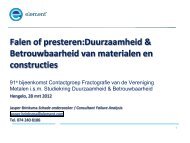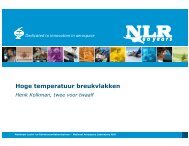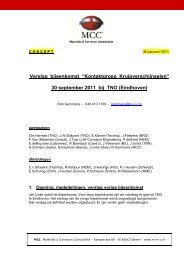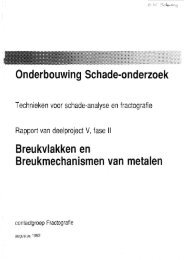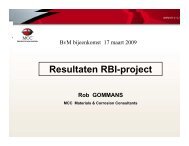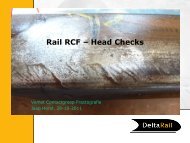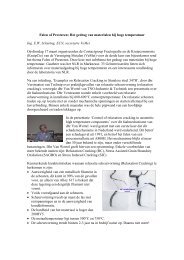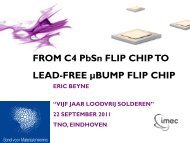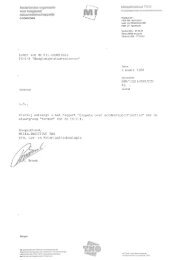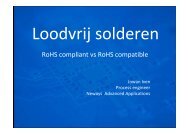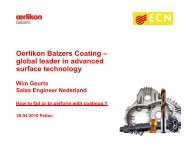Reinigingsonderzoek met waterige (alkalische) oplossingen - VeMet
Reinigingsonderzoek met waterige (alkalische) oplossingen - VeMet
Reinigingsonderzoek met waterige (alkalische) oplossingen - VeMet
Create successful ePaper yourself
Turn your PDF publications into a flip-book with our unique Google optimized e-Paper software.
SUMMARY<br />
High temperature vacuum brazing is a clean and environmental friendly joining technique capable<br />
of joining similar and dissimilar materials and constructions which can not easily be joint by<br />
e.g. welding.<br />
Good quality brazings have mechanical properties comparable to weldings. However, a clean<br />
surface before brazing is necessary. Nowadays, new regulations restrict or even forbid the use of<br />
CFK based cleaning <strong>met</strong>hods, which, in the past gave good results. To maintain high temperature<br />
vacuum brazing as a clean and environmental joining technique new cleaning <strong>met</strong>hods will<br />
have to be introduced. Water based Alkaline solutions is one of the possibilities. Therefore,<br />
NIL-TC1-A initiated a project to investigate he possibilities of water based alkaline solutions<br />
for the cleaning of carbon steel, austenitic stainless steel and copper. Final aim of the project<br />
was to set up a draft proposal for a guideline to develop and/or optimise a cleaning procedure,<br />
using environmental friendly cleaning <strong>met</strong>hods. The materials were machined and subjected to a<br />
deep draw process, using appropriate fluids. As cleaning fluids, silicate free, water based solutions<br />
were used. High alkaline (pH = 13) for C-steel and stainless steel and neutral with surface<br />
active additives for copper. As a reference, degreasing in cyclohexane was also performed.<br />
Since ageing has a negative influence on the cleanibility, also aged surfaces were cleaned. The<br />
surfaces of the materials were characterised by XPS, an indirect <strong>met</strong>hod using testing fluids for<br />
the determination of the surface energy and in a brazing test.<br />
XPS was used to determine a value for the surface, contamination as a C/Me ratio. A higher<br />
ratio indicates a higher contamination.<br />
The indirect <strong>met</strong>hod for determining the surface energies was used as a quick and easy<br />
<strong>met</strong>hod to determine the surface cleanliness and for the optimisation of the cleaning procedure.<br />
The brazing test was used as reference to get an indication of the expected brazing result.<br />
The samples were mainly inspected for discoloration.<br />
The results can be summarised as follows:<br />
In general, cutting fluids can easily be removed in both the unaged and aged condition.<br />
Standard procedure is sufficient.<br />
Deep draw fluids however are more difficult to remove. As for cutting fluids, simple agitation<br />
is enough to remove the fluids, for deep drawn products, ultrasonic consistent cleaning<br />
is necessary. And even then, not always all is removed. In the case of copper, a more alkaline<br />
solution will be required.<br />
The indirect <strong>met</strong>hod using testing fluids for the determination of the surface energy proved<br />
to be ver useful. The <strong>met</strong>hod can be used to monitor the cleaning process. Comparing the<br />
XPS-results and the indirect <strong>met</strong>hod shows that up to a certain degree of degreasing both<br />
<strong>met</strong>hods can be used. Above a certain level of cleanness the indirect <strong>met</strong>hod is not applicable<br />
to distinguish anymore. However, the fluids used have a limited range between 44-30 mN/m.<br />
Using fluids with higher values (up to 58 mN/m) may be better. Finally, a cleaning procedure<br />
for the optimisation or the introduction of a cleaning procedure is suggested.<br />
Adoption the cleaning procedure is expected to enhance the acceptance of water based alkaline<br />
solutions in cleaning, thereby reducing the emission of hydrocarbon to the atmosphere.<br />
ECN-CX--01-088 7



